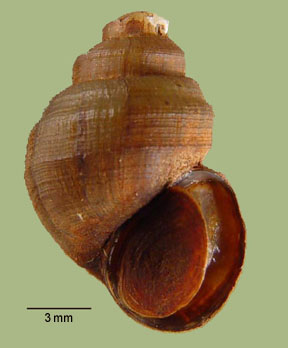Lioplax sulculosa (Menke 1828)
> Habitat & Distribution
The range of Lioplax subcarinata (under all synonyms) historically extended from Wisconsin and New York south to Arkansas and Florida (Clench & Turner 1955, Clench 1962b, 1965, Vail 1979). Jokinen (1992) reported that this species seems to have been extirpated from New York, however, and we ourselves are aware of only a single modern record anywhere north of the Potomac. Our surveys of Atlantic drainages have found populations of L. subcarinata distributed in patchy fashion through coastal plain portions of the Lynches, Waccamaw, Lower Neuse, Tar/Pamlico, and Chowan Rivers. Lioplax populations become more common in the Gulf drainages of Georgia and the Florida panhandle.
In interior drainages, Lioplax populations range up the Ohio River to the vicinity of Cincinnati, including the lower portions of the Wabash, the Salt, and the Licking, and up the Tennessee River to the vicinity of Chattanooga, including tributaries in North Alabama. Our limited observations suggest that the animal burrows in flocculent silt. FWGNA incidence rank I-4.
> Ecology & Life History
The ecological literature contains few studies specifically addressing Lioplax. But judging from its biological similarity to Campeloma, one might infer that Lioplax has the ability to filter feed or suspension feed on fine organic particles. Unlike Campeloma, however, there is no evidence of parthenogenesis in Lioplax, as far as we are aware (Vail 1977). Vail (1978) reported a perennial, iteroparous life cycle for the population of Lioplax pilsbryi she studied in north Florida (Hi of Dillon 2000), animals requiring two years to mature.
> Taxonomy & Systematics
Clench & Turner (1955) and Clench (1962a) recognized four North American species of Lioplax, a cognate pair in Gulf drainages (cyclostomaformis and pilsbryi) and a cognate pair further north. Vail (1977) has published a nice set of anatomical observations on her Lioplax pilsbryi population from Florida.
The northern pair of cognates, L. subcarinata (Say, 1817) in Atlantic drainages and L. sulculosa (Menke, 1828) in interior drainages, were characterized by Clench & Turner as "exceedingly close" in their relationship, observing that "Their characters differ mainly in degree." We are unable to see any degree of difference whatsoever between Lioplax subcarinata and L. sulculosa, here considering the latter name a junior synonym of the former.
The southern pair of cognates, cyclostomaformis and pilsbryi, seem to differ from the northern pair by the deeper impression of their shell suture. They may deserve subspecific recognition, although the specific importance of that distinction is difficult to guage.
> Maps and Supplementary Resources
- Lioplax distribution in Atlantic drainages (2023)
- Lioplax distribution in Georgia and the Florida panhandle (2025).
- Lioplax in the drainage of The Ohio (2019)
- Lioplax in the Tennessee/Cumberland (2022)
> Essays
- I published an essay reporting the rediscovery of Lioplax in South Carolina on 26Aug04. Photos of the habitat and the living animal are available from that page.
- The sad fate of the Waccamaw population of Lioplax subcarinata was mentioned in my post of 16July10, "Crisis at Lake Waccamaw."
> References
Burch, J. B. (1989) North American Freshwater Snails. Malacological Publications, Hamburg, MI. 365 pp.
Dillon, R. T., Jr. (2000) The Ecology of Freshwater Molluscs. Cambridge University Press, United Kingdom. 509 pp.
Clench, W. (1962a) A catalogue of the Viviparidae of North America with notes on the distribution of Viviparus georgianus Lea. Occas. Pprs. on Mollusks, Mus. Comp. Zool. Harvard 2(27) 261 - 287.
Clench, W. (1962b) New records of the genus Lioplax. Occas. Pprs. on Mollusks, Mus. Comp. Zool. Harvard, 2(27): 288.
Clench, W. (1965) Supplement to the North American genus Lioplax. Occas. Pprs. on Mollusks, Mus. Comp. Zool. Harvard, 2(34): 426.
Clench, W. & Turner, R. D. (1955) The North American genus Lioplax in the family Viviparidae. Occas. Pprs. on Mollusks, Mus. Comp. Zool. Harvard 2(19): 1 20.
Jokinen, E. (1992) The freshwater snails (Mollusca: Gastropoda) of New York State. New York State Museum Bulletin 482: 1-112.
Vail, V.A. (1977) Comparative reproductive anatomy of 3 viviparid gastropods. Malacologia 16: 519-520.
Vail, V.A. (1978) Seasonal reproductive patterns in 3 viviparid gastropods. Malacologia 17: 73-97.
Vail, V.A. (1979) A preliminary revision of Florida Lioplax (Gastropoda: Viviparidae) with a description of Lioplax talquinensis sp. nov. Malacol. Rev. 12: 87 88.








